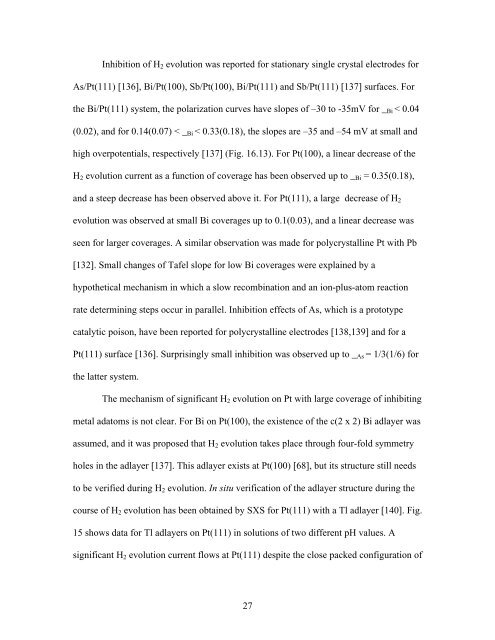electrocatalysis on surfaces modified... - Brookhaven National ...
electrocatalysis on surfaces modified... - Brookhaven National ...
electrocatalysis on surfaces modified... - Brookhaven National ...
You also want an ePaper? Increase the reach of your titles
YUMPU automatically turns print PDFs into web optimized ePapers that Google loves.
Inhibiti<strong>on</strong> of H 2 evoluti<strong>on</strong> was reported for stati<strong>on</strong>ary single crystal electrodes for<br />
As/Pt(111) [136], Bi/Pt(100), Sb/Pt(100), Bi/Pt(111) and Sb/Pt(111) [137] <strong>surfaces</strong>. For<br />
the Bi/Pt(111) system, the polarizati<strong>on</strong> curves have slopes of –30 to -35mV for _ Bi < 0.04<br />
(0.02), and for 0.14(0.07) < _ Bi < 0.33(0.18), the slopes are –35 and –54 mV at small and<br />
high overpotentials, respectively [137] (Fig. 16.13). For Pt(100), a linear decrease of the<br />
H 2 evoluti<strong>on</strong> current as a functi<strong>on</strong> of coverage has been observed up to _ Bi = 0.35(0.18),<br />
and a steep decrease has been observed above it. For Pt(111), a large decrease of H 2<br />
evoluti<strong>on</strong> was observed at small Bi coverages up to 0.1(0.03), and a linear decrease was<br />
seen for larger coverages. A similar observati<strong>on</strong> was made for polycrystalline Pt with Pb<br />
[132]. Small changes of Tafel slope for low Bi coverages were explained by a<br />
hypothetical mechanism in which a slow recombinati<strong>on</strong> and an i<strong>on</strong>-plus-atom reacti<strong>on</strong><br />
rate determining steps occur in parallel. Inhibiti<strong>on</strong> effects of As, which is a prototype<br />
catalytic pois<strong>on</strong>, have been reported for polycrystalline electrodes [138,139] and for a<br />
Pt(111) surface [136]. Surprisingly small inhibiti<strong>on</strong> was observed up to _ As = 1/3(1/6) for<br />
the latter system.<br />
The mechanism of significant H 2 evoluti<strong>on</strong> <strong>on</strong> Pt with large coverage of inhibiting<br />
metal adatoms is not clear. For Bi <strong>on</strong> Pt(100), the existence of the c(2 x 2) Bi adlayer was<br />
assumed, and it was proposed that H 2 evoluti<strong>on</strong> takes place through four-fold symmetry<br />
holes in the adlayer [137]. This adlayer exists at Pt(100) [68], but its structure still needs<br />
to be verified during H 2 evoluti<strong>on</strong>. In situ verificati<strong>on</strong> of the adlayer structure during the<br />
course of H 2 evoluti<strong>on</strong> has been obtained by SXS for Pt(111) with a Tl adlayer [140]. Fig.<br />
15 shows data for Tl adlayers <strong>on</strong> Pt(111) in soluti<strong>on</strong>s of two different pH values. A<br />
significant H 2 evoluti<strong>on</strong> current flows at Pt(111) despite the close packed c<strong>on</strong>figurati<strong>on</strong> of<br />
27
















